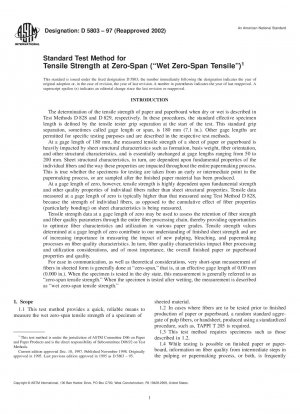ASTM D5803-97(2002)
Standard Test Method for Tensile Strength at Zero-Span ("Wet Zero-Span Tensile")
- Standard No.
- ASTM D5803-97(2002)
- Release Date
- 1997
- Published By
- American Society for Testing and Materials (ASTM)
- Status
- 2009-08
- Latest
- ASTM D5803-97(2002)
- Scope
The wet zero-span tensile test measures the tensile strength at the moment of tensile failure of wet fibers, which are clamped in the two jaws of a suitable tensile tester. The wet zero-span tensile value may be used to assess the tensile strength of individual fibers in their length dimension when wet.
For unbeaten chemical pulps, the wet zero-span tensile test is a very sensitive measure of the loss in individual fiber strength in the length dimension (axial tensile strength of the individual fibers) due to pulping and bleaching.
For mechanical pulps, the wet zero tensile test is a very sensitive measure of quality and strength of the finished sheet in terms of fines content and particle size, because the absence of a harsh chemical environment over a significant time means that the strength of the individual fibers undergoes minimal change.
Wet zero-span tensile data may be used to indicate individual fiber strength and guide the best utilization of fibers of unknown history, such as recycled fiber material.
The relationship between the strength of a fibrous sheet is determined by methods such as Test Methods D 828 and D 829
fibers, and the strength of the individual fiber comprising the sheet is important to overall properties of the finished sheet and may be studied using this test method. More theoretical interpretations of wet zero-span will be found in the early work of Van den Akker (5) and the later work of Boucai (6). See Appendix X1.
1.1 This test method provides a quick, reliable means to measure the wet zero-span tensile strength of a specimen of sheeted material.
1.2 In cases where fibers are to be tested prior to finished production of paper or paperboard, a random standard aggregate of pulp fibers, or handsheet, produced using a standardized procedure, such as, TAPPI T205 is required.
1.3 This test method requires specimens such as those described in 1.2.
1.4 While testing is possible on finished paper or paperboard, information on fiber quality from intermediate steps in the pulping or papermaking process, or both, is frequently more useful for improving finished paper and paperboard quality or improving fiber utilization of recycled fibers, or fibers subjected to new pulping, bleaching, or finishing processes (1, 2, 3, 4).
1.5 The modifications of this test method required for testing finished paper is straightforward; however, testing shall be done in the two principle directions of the sheet, as required in Test Method D829. The finished paper or paperboard will generally have nonrandom fiber orientation, resulting in different strength properties in the two principle directions of the finished sheet. Testing of sheets having a grammage greater than 100 g/m, which includes some paper materials described as paper and many paperboards, is difficult because of problems associated with clamping of individual fibers as the number of fibers per unit area increases.
1.6 Modifications such as those in 1.5 are not described in this test method. If modifications are made, they must be acknowledged and clearly described in the report as deviations from the standard procedure.
1.7 This standard does not purport to address all of the safety concerns, if any, associated with its use. It is the responsibility of the user of this standard to establish appropriate safety and health practices and determine the applicability of regulatory limitations prior to use.
ASTM D5803-97(2002) Referenced Document
- ASTM D1193 Standard Specification for Reagent Water*, 1999-04-19 Update
- ASTM D1968 Standard Terminology Relating to Paper and Paper Products*, 1999-04-19 Update
- ASTM D586 Standard Test Method for Ash in Pulp, Paper, and Paper Products
- ASTM D828 Standard Test Method for Tensile Properties of Paper and Paperboard Using Constant-Rate-of-Elongation Apparatus
- ASTM D829 Standard Test Methods for Wet Tensile Breaking Strength of Paper and Paper Products
- ASTM E122 Standard Practice for Calculating Sample Size to Estimate, With a Specified Tolerable Error, the Average for Characteristic of a Lot or Process*, 2000-10-10 Update
ASTM D5803-97(2002) history
- 1997 ASTM D5803-97(2002) Standard Test Method for Tensile Strength at Zero-Span ("Wet Zero-Span Tensile")
- 1997 ASTM D5803-97 Standard Test Method for Tensile Strength at Zero-Span ("Wet Zero-Span Tensile")
